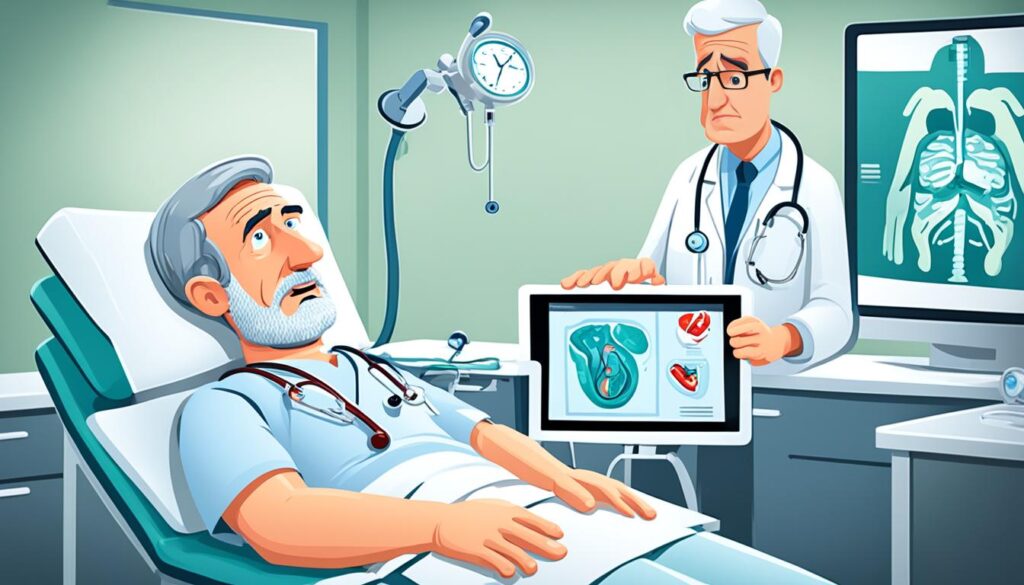Imagine food quickly moving from your stomach to your small intestine, causing discomfort. This is what happens with gastric dumping syndrome after stomach or esophageal surgery. We’ll discuss the causes, symptoms, and treatment. This guide aims to help you understand and deal with this condition.
Table of Contents
ToggleAfter reading, you’ll understand more about gastric dumping syndrome. You’ll learn who’s at risk and ways to prevent or manage the symptoms. Whether you recently had surgery or want to learn, this guide is for you. It offers the knowledge to take charge of your health.
Understanding Gastric Dumping Syndrome
Gastric dumping syndrome happens after some stomach or esophagus surgeries. When food moves too quickly from your stomach to your small intestine, you might feel sick. This can cause several problems, making life difficult.
What is Gastric Dumping Syndrome?
This syndrome makes stomach contents, like food and drinks, quickly move into the small intestine. Surgery can change how our stomachs and digestive systems work. It’s at that moment when things go awry.
Who is at Risk for Developing This Condition?
People who have had stomach or esophageal surgeries face a higher risk. Procedures like gastric bypass or gastrectomy disrupt the digestion process. This leads to rapid stomach emptying, causing the syndrome.

Causes of Gastric Dumping Syndrome
Gastric dumping syndrome is often caused by surgery on the stomach. This includes gastric bypass surgery. These operations change how the stomach and digestion work.
Gastric Bypass Surgery
Gastric bypass surgery helps with weight loss but can lead to dumping syndrome. It makes a new, smaller stomach pouch. This is then connected to the small intestine.
Food passes too quickly into the intestine. This causes the problems seen in dumping syndrome.
Other Surgical Procedures
Other surgeries besides gastric bypass can also cause dumping syndrome. These are:
- Gastrectomy (partial or total removal of the stomach)
- Esophagectomy (removal of part of the esophagus)
- Vagotomy (surgical interruption of the vagus nerve)
These surgeries change how food moves in your body. As a result, they can lead to dumping syndrome.
Symptoms of Gastric Dumping Syndrome
Gastric dumping syndrome brings many bad symptoms that fall into two groups. These are early dumping symptoms and late dumping symptoms.
Early Dumping Symptoms
Early dumping symptoms happen within 30 minutes of eating. You might feel sick or need to vomit. Stomach pain, bloating, and loose stool are common. Feeling too full or just uncomfortable happens too. You might also get dizzy, sweat a lot, or feel your heart racing.
Late Dumping Symptoms
Late dumping symptoms start 1 to 3 hours after you eat. These can include feeling weak, tired, dizzy, and confused. You may sweat more. This is because your body might make too much insulin. That can make your blood sugar drop too low.

Knowing the differences between early and late dumping symptoms is key. It can help you see how your body reacts to food. Working with your doctor is critical. Together, you can create a plan to tackle your specific symptoms.
Diagnosing Gastric Dumping Syndrome
Your doctor will start by talking with you. They’ll ask about your health and any surgeries. This helps start the diagnosis process.
Medical History and Physical Examination
Your doctor will ask detailed questions. They want to know when your symptoms happen and how bad they are. Changes in diet or medicines are crucial to mention too.
Then, they will do a physical check-up. Checking your heart rate, pressing on your stomach, and checking for nutritional or dehydration signs are all parts of it.
Diagnostic Tests
After the first steps, more tests might be needed. This is to be sure about the diagnosis. Some common tests are:
- Dumping Provocation Test: You drink a sugary liquid and symptoms are watched. Blood sugar levels are also checked.
- Gastric Emptying Study: A small amount of radioactive material shows how food moves in your body.
- Hydrogen Breath Test: This checks how your body is absorbing carbs by measuring the hydrogen in your breath.
- Upper Gastrointestinal (GI) Endoscopy: A tiny camera looks at your upper digestive system for problems.
By understanding your health history, doing a physical exam, and running tests, the doctor can diagnose dumping syndrome. Then, a dumping syndrome treatment plan can be made to help you feel better and live a healthier life.

Gastric Dumping Syndrome: Prevention and Management
How to prevent dumping syndrome, we use different methods. This includes stopping symptoms before they start and dealing with them if they show up. Tackling the issue might involve changing what you eat, taking medicine, and sometimes having surgery.
Dietary Modifications
Changing your diet is key to handling gastric dumping syndrome. Your doctor or a dietitian could suggest various eating habits. This might include having smaller meals more often during the day.
- Eating smaller, more frequent meals throughout the day to avoid overloading the digestive system
- Limiting the consumption of high-sugar and high-fat foods, which can exacerbate dumping symptoms
- Increasing the intake of fiber-rich foods, such as fruits, vegetables, and whole grains, to help slow the transit of food through the digestive tract
- Staying hydrated by drinking fluids, preferably water, between meals rather than during meals
Medications
If changing your diet isn’t enough, your doctor might give you medicine. This can help control the symptoms of gastric dumping syndrome. Here are some medicines they might use:
| Medication | Mechanism of Action | Potential Benefits |
|---|---|---|
| Octreotide (Sandostatin) | Slows the movement of food through the digestive tract | Reduces early and late dumping symptoms |
| Alpha-glucosidase inhibitors (Acarbose) | Slows the absorption of carbohydrates | Helps manage late dumping symptoms |
| Proton pump inhibitors (Omeprazole) | Reduces stomach acid production | Alleviates symptoms related to early dumping |
Surgical Interventions
When changing your diet and taking medicine don’t help, surgery might be an option. Your doctor could suggest different surgeries. Here are a few:
- Reversal of the original gastric bypass surgery to restore the normal anatomy of the digestive system
- Lengthening of the small intestine to slow the transit of food through the digestive tract
- Implantation of a gastric pacemaker device to regulate stomach emptying
By making changes in your diet, taking prescribed medicines, and sometimes having surgery, you play an important role. This helps in preventing and managing gastric dumping syndrome. It can make your life better.
Conclusion
After some stomach and esophageal surgeries, like gastric bypass or gastrectomy, gastric dumping syndrome might happen. Knowing what causes it, its symptoms, and the treatments can help a lot. This way, you can manage the condition and feel better.
Doctors focus on easing symptoms and avoiding problems with gastric dumping syndrome. They use diet changes, medicine, and sometimes surgery. With the correct help, you can handle this condition and live well.
You’re not alone if you have gastric dumping syndrome. Learning more and working with your healthcare team are key. With a plan that matches your needs, you can get your digestion back on track. Stay active in your care, keep talking with your doctors, and use the help available. This will lead to a better recovery and life.
FAQ
What is Gastric Dumping Syndrome?
Who is at Risk for Developing Gastric Dumping Syndrome?
What are the Causes of Dumping Syndrome?
What are the Symptoms of Gastric Dumping Syndrome?
How is Gastric Dumping Syndrome Diagnosed?
How Can Gastric Dumping Syndrome Be Prevented and Managed?


